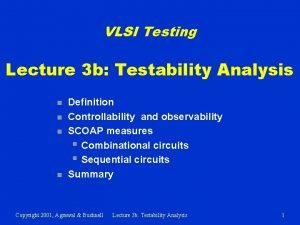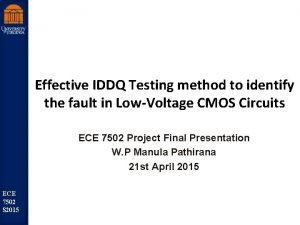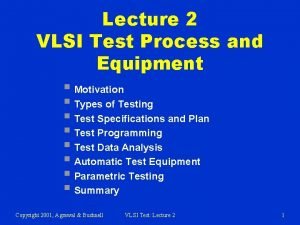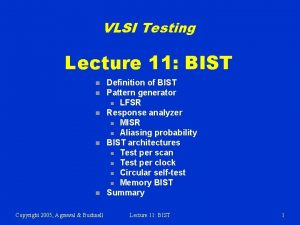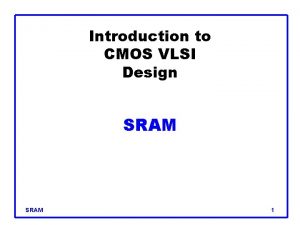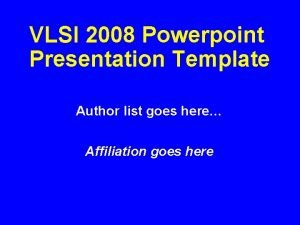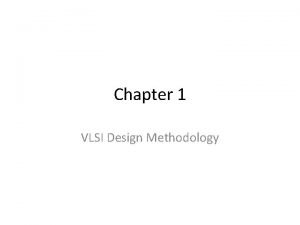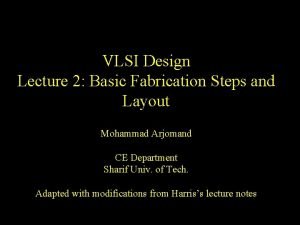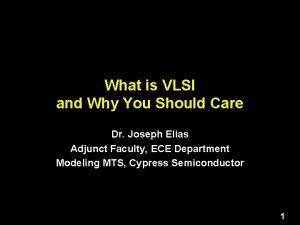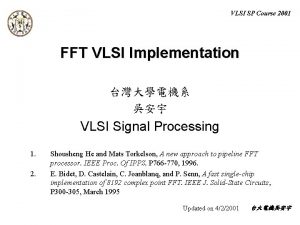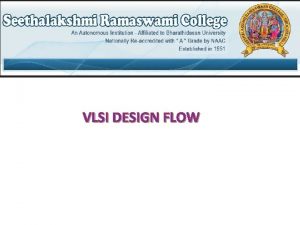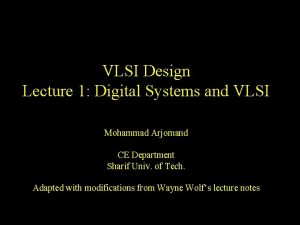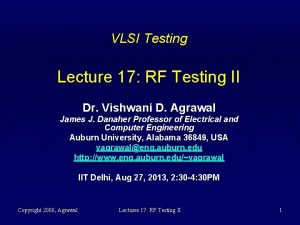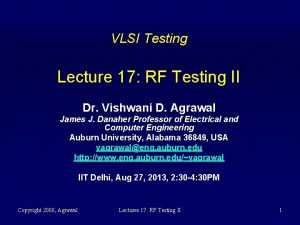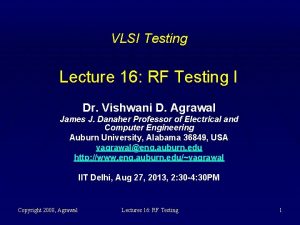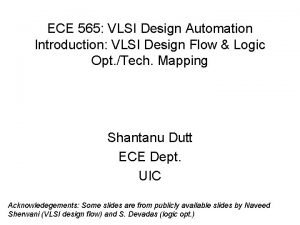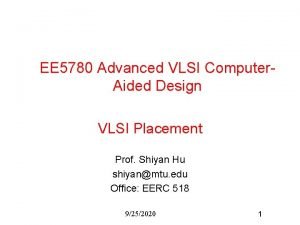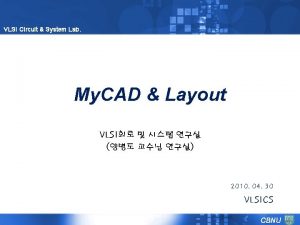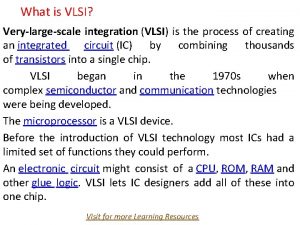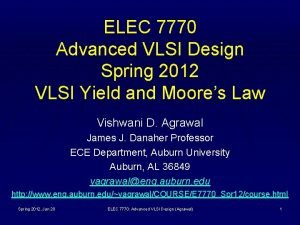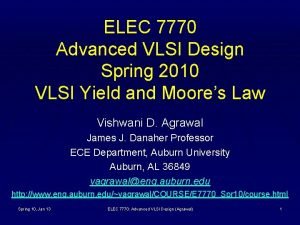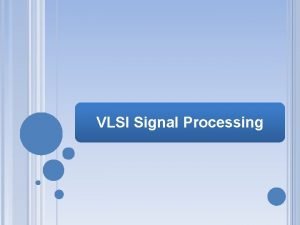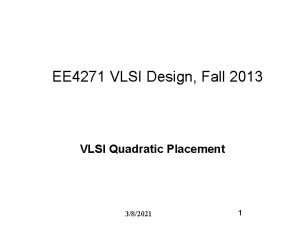VLSI Testing Lecture 16 RF Testing I Dr




























- Slides: 28

VLSI Testing Lecture 16: RF Testing I Dr. Vishwani D. Agrawal James J. Danaher Professor of Electrical and Computer Engineering Auburn University, Alabama 36849, USA vagrawal@eng. auburn. edu http: //www. eng. auburn. edu/~vagrawal IIT Delhi, Aug 27, 2013, 2: 30 -4: 30 PM Copyright 2008, Agrawal Lectures 16: RF Testing 1

References 1. S. Bhattacharya and A. Chatterjee, "RF Testing, " Chapter 16, pages 2. 3. 4. 5. 6. 745 -789, in System on Chip Test Architectures, edited by L. -T. Wang, C. E. Stroud and N. A. Touba, Amsterdam: Morgan-Kaufman, 2008. M. L. Bushnell and V. D. Agrawal, Essentials of Electronic Testing for Digital, Memory & Mixed-Signal VLSI Circuits, Boston: Springer, 2000. J. Kelly and M. Engelhardt, Advanced Production Testing of RF, So. C, and Si. P Devices, Boston: Artech House, 2007. B. Razavi, RF Microelectronics, Upper Saddle River, New Jersey: Prentice Hall PTR, 1998. J. Rogers, C. Plett and F. Dai, Integrated Circuit Design for High. Speed Frequency Synthesis, Boston: Artech House, 2006. K. B. Schaub and J. Kelly, Production Testing of RF and System-on-achip Devices for Wireless Communications, Boston: Artech House, 2004. Copyright 2008, Agrawal Lectures 16: RF Testing 2

An RF Communications System Superheterodyne Transceiver 0° VGA LNA Phase Splitter LO Duplexer 90° ADC LO DAC 0° PA VGA Phase Splitter LO 90° Digital Signal Processor (DSP) ADC DAC RF Copyright 2008, Agrawal IF Lectures 16: RF Testing BASEBAND 3

Components of an RF System § Radio frequency § Mixed-signal § Duplexer § LNA: Low noise amplifier § PA: Power amplifier § RF mixer § Local oscillator § Filter § ADC: Analog to digital converter § DAC: Digital to analog converter § Digital § Intermediate frequency § Digital signal processor (DSP) § VGA: Variable gain amplifier § Modulator § Demodulator § Filter Copyright 2008, Agrawal Lectures 16: RF Testing 4

LNA: Low Noise Amplifier § Amplifies received RF signal § Typical characteristics: § Noise figure § IP 3 § Gain § Input and output impedance § Reverse isolation § Stability factor 2 d. B – 10 d. Bm 15 d. B 50Ω 20 d. B >1 § Technologies: § Bipolar § CMOS § Reference: Razavi, Chapter 6. Copyright 2008, Agrawal Lectures 16: RF Testing 5

PA: Power Amplifier § Feeds RF signal to antenna for transmission § Typical characteristics: § § § Output power +20 to +30 d. Bm § Efficiency 30% to 60% § IMD – 30 d. Bc § Supply voltage 3. 8 to 5. 8 V § Gain 20 to 30 d. B § Output harmonics – 50 to – 70 d. Bc § Power control On-off or 1 -d. B steps § Stability factor >1 Technologies: § Ga. As § Si. Ge Reference: Razavi, Chapter 9. Copyright 2008, Agrawal Lectures 16: RF Testing 6

Mixer or Frequency (Up/Down) Converter § Translates frequency by adding or subtracting § local oscillator (LO) frequency Typical characteristics: § Noise figure § IP 3 § Gain § Input impedance § Port to port isolation 12 d. B +5 d. Bm 10 d. B 50Ω 10 -20 d. B § Tecnologies: § Bipolar § MOS § Reference: Razavi, Chapter 6. Copyright 2008, Agrawal Lectures 16: RF Testing 7

LO: Local Oscillator § Provides signal to mixer for down conversion or § upconversion. Implementations: § Tuned feedback amplifier § Ring oscillator § Phase-locked loop (PLL) § Direct digital synthesizer (DDS) Copyright 2008, Agrawal Lectures 16: RF Testing 8

SOC: System-on-a-Chip § All components of a system are implemented on § § the same VLSI chip. Requires same technology (usually CMOS) used for all components. Components not implemented on present-day SOC: § Antenna § Power amplifier (PA) Copyright 2008, Agrawal Lectures 16: RF Testing 9

RF Tests § Basic tests § § § Scattering parameters (S-parameters) § Frequency and gain measurements § Power efficiency measurements Distortion measurements Noise measurements Copyright 2008, Agrawal Lectures 16: RF Testing 10

Scattering Parameters (S-Parameters) § An RF function is a two-port device with § Characteristic impedance (Z 0): § Z 0 = 50Ω for wireless communications devices § Z 0 = 75Ω for cable TV devices § Gain and frequency characteristics § S-Parameters of an RF device § S 11 : input return loss or input reflection coefficient § S 22 : output return loss or output reflection coefficient § S 21 : gain or forward transmission coefficient § S 12 : isolation or reverse transmission coefficient § S-Parameters are complex numbers and can be expressed in decibels as 20 × log | Sij | Copyright 2008, Agrawal Lectures 16: RF Testing 11

Active or Passive RF Device a 1 Port 1 (input) a 2 RF Device b 1 b 2 Input return loss Output return loss Gain Isolation Copyright 2008, Agrawal Port 2 (output) Lectures 16: RF Testing S 11 = b 1/a 1 S 22 = b 2/a 2 S 21 = b 2/a 1 S 12 = b 1/a 2 12

S-Parameter Measurement: Network Analyzer Directional couplers DUT a 1 Digitizer b 1 Directional couplers a 2 Digitizer b 2 Copyright 2008, Agrawal Lectures 16: RF Testing 13

Application of S-Parameter: Input Match § Example: In an S-parameter measurement setup, rms value of input voltage is 0. 1 V and the rms value of the reflected voltage wave is 0. 02 V. Assume that the output of DUT is perfectly matched. Then S 11 determines the input match: § S 11 = 0. 02/0. 1 = 0. 2, or 20 × log (0. 2) = – 14 d. B. § Suppose the required input match is – 10 d. B; this device passes the test. § Similarly, S 22 determines the output match. Copyright 2008, Agrawal Lectures 16: RF Testing 14

Gain (S 21) and Gain Flatness § An amplifier of a Bluetooth transmitter operates over a § § § frequency band 2. 4 – 2. 5 GHz. It is required to have a gain of 20 d. B and a gain flatness of 1 d. B. Test: Under properly matched conditions, S 21 is measured at several frequencies in the range of operation: § S 21 = 15. 31 at 2. 400 GHz § S 21 = 14. 57 at 2. 499 GHz From the measurements: § At 2. 400 GHz, Gain = 20×log 15. 31 = 23. 70 d. B § At 2. 499 GHz, Gain = 20×log 14. 57 = 23. 27 d. B Result: Gain and gain flatness meet specification. Measurements at more frequencies in the range may be useful. Copyright 2008, Agrawal Lectures 16: RF Testing 15

Power Measurements § Receiver § § § Minimum detectable RF power Maximum allowed input power Power levels of interfering tones § Transmitter § § Maximum RF power output Changes in RF power when automatic gain control is used RF power distribution over a frequency band Power-added efficiency (PAE) § Power unit: d. Bm, relative to 1 m. W § § § Power in d. Bm = 10 × log (power in watts/0. 001 watts) Example: 1 W is 10×log 1000 = 30 d. Bm What is 2 W in d. Bm? Copyright 2008, Agrawal Lectures 16: RF Testing 16

Harmonic Measurements § Multiples of the carrier frequency are called § § harmonics. Harmonics are generated due to nonlinearity in semiconductor devices and clipping (saturation) in amplifiers. Harmonics may interfere with other signals and must be measured to verify that a manufactured device meets the specification. Copyright 2008, Agrawal Lectures 16: RF Testing 17

Power-Added Efficiency (PAE) § Definition: Power-added efficiency of an RF amplifier is § § § the ratio of RF power generated by the amplifier to the DC power supplied: § PAE = ΔPRF / PDC where § ΔPRF = PRF(output) – PRF(input) § Pdc = Vsupply × Isupply Important for power amplifier (PA). 1 – PAE is a measure of heat generated in the amplifier, i. e. , the battery power that is wasted. In mobile phones PA consumes most of the power. A low PAE reduces the usable time before battery recharge. Copyright 2008, Agrawal Lectures 16: RF Testing 18

PAE Example § Following measurements are obtained for an RF § power amplifier: § RF Input power = +2 d. Bm § RF output power = +34 d. Bm § DC supply voltage = 3 V § DUT current = 2. 25 A PAE is calculated as follows: § PRF(input) = 0. 001 × 102/10 = 0. 0015 W § PRF(output) = 0. 001 × 1034/10 = 2. 5118 W § Pdc = 3× 2. 25 = 6. 75 W § PAE = (2. 5118 – 0. 00158)/6. 75 = 0. 373 or 37. 2% Copyright 2008, Agrawal Lectures 16: RF Testing 19

Distortion and Linearity § An unwanted change in the signal behavior is § § usually referred to as distortion. The cause of distortion is nonlinearity of semiconductor devices constructed with diodes and transistors. Linearity: § Function f(x) = ax + b, although a straight-line is not § referred to as a linear function. Definition: A linear function must satisfy: § f(x + y) = f(x) + f(y), and § f(ax) = a f(x), for all scalar constants a Copyright 2008, Agrawal Lectures 16: RF Testing 20

Linear and Nonlinear Functions f(x) slope = a b b x x f(x) = ax + b f(x) = ax 2 + b f(x) slope = a x f(x) = ax Copyright 2008, Agrawal Lectures 16: RF Testing 21

Generalized Transfer Function § Transfer function of an electronic circuit is, in § general, a nonlinear function. Can be represented as a polynomial: § vo = a 0 + a 1 vi + a 2 vi 2 + a 3 vi 3 + · · § Constant term a 0 is the dc component that in RF § circuits is usually removed by a capacitor or highpass filter. For a linear circuit, a 2 = a 3 = · · = 0. Electronic vi Copyright 2008, Agrawal circuit Lectures 16: RF Testing vo 22

Effect of Nonlinearity on Frequency § § Consider a transfer function, vo = a 0 + a 1 vi + a 2 vi 2 + a 3 vi 3 Let vi = A cos ωt Using the identities (ω = 2πf): § cos 2 ωt = (1 + cos 2ωt)/2 § cos 3 ωt = (3 cos ωt + cos 3ωt)/4 We get, § vo Copyright 2008, Agrawal = a 0 + a 2 A 2/2 + (a 1 A + 3 a 3 A 3/4) cos ωt + (a 2 A 2/2) cos 2ωt + (a 3 A 3/4) cos 3ωt Lectures 16: RF Testing 23

Problem for Solution § A diode characteristic is, I = Is ( eαV – 1) § Where, V = V 0 + vin, V 0 is dc voltage and vin is small signal ac § voltage. Is is saturation current and α is a constant that depends on temperature and design parameters of diode. Using the Taylor series expansion, express the diode current I as a polynomial in vin. I 0 V – Is Copyright 2008, Agrawal Lectures 16: RF Testing 24

Linear and Nonlinear Circuits and Systems § Linear devices: § All frequencies in the output of a device are related to § input by a proportionality, or weighting factor, independent of power level. § No frequency will appear in the output, that was not present in the input. Nonlinear devices: § A true linear device is an idealization. Most electronic devices are nonlinear. § Nonlinearity in amplifier is undesirable and causes distortion of signal. § Nonlinearity in mixer or frequency converter is essential. Copyright 2008, Agrawal Lectures 16: RF Testing 25

Types of Distortion and Their Tests § Types of distortion: § Harmonic distortion: single-tone test § Gain compression: single-tone test § Intermodulation distortion: two-tone or multitone test § Testing procedure: Output spectrum measurement Copyright 2008, Agrawal Lectures 16: RF Testing 26

Harmonic Distortion § Harmonic distortion is the presence of multiples of a § § fundamental frequency of interest. N times the fundamental frequency is called Nth harmonic. Disadvantages: § Waste of power in harmonics. § Interference from harmonics. Measurement: § Single-frequency input signal applied. § Amplitudes of the fundamental and harmonic frequencies are analyzed to quantify distortion as: § Total harmonic distortion (THD) § Signal, noise and distortion (SINAD) Copyright 2008, Agrawal Lectures 16: RF Testing 27

Problem for Solution § Show that for a nonlinear device with a single frequency input of amplitude A, the nth harmonic component in the output always contains a term proportional to An. Copyright 2008, Agrawal Lectures 16: RF Testing 28
 Cmos vlsi design lecture notes
Cmos vlsi design lecture notes 01:640:244 lecture notes - lecture 15: plat, idah, farad
01:640:244 lecture notes - lecture 15: plat, idah, farad Controllability and observability in vlsi testing
Controllability and observability in vlsi testing What is iddq testing
What is iddq testing Shmoo plot
Shmoo plot Decision table testing in software testing
Decision table testing in software testing Domain testing example
Domain testing example Black-box testing disebut juga sebagai behavioral testing
Black-box testing disebut juga sebagai behavioral testing Cs 3250
Cs 3250 Component testing is a black box testing
Component testing is a black box testing Control structure testing in software engineering
Control structure testing in software engineering Motivational overview of logic based testing
Motivational overview of logic based testing Decision table based testing in software testing
Decision table based testing in software testing Globalization testing example
Globalization testing example Types of domain testing
Types of domain testing Decision table testing example
Decision table testing example Decision table testing in software testing
Decision table testing in software testing Data flow testing strategies in software testing
Data flow testing strategies in software testing Rigorous testing in software testing
Rigorous testing in software testing Neighborhood integration testing
Neighborhood integration testing Contoh pengujian equivalence partitioning
Contoh pengujian equivalence partitioning Positive vs negative testing
Positive vs negative testing Testing blindness in software testing
Testing blindness in software testing Bilbo in vlsi
Bilbo in vlsi Vlsi
Vlsi Vlsi ppt presentation
Vlsi ppt presentation In which method regularity is used to reduce complexity
In which method regularity is used to reduce complexity Inverter mask set
Inverter mask set Isvlsi
Isvlsi


